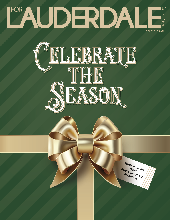From the annals of what we call the Greater Fort Lauderdale Metropolitan Area, last month’s column featured several villages that came to be incorporated into the city’s orbit.
Towns like the wacky Hacienda Village, known as a speed trap, came and went. Or the town of Davie, first settled by families who called it “Zona” and helped dig the Panama Canal Zone. Or the city of Margate, which expanded with land purchased by John D. Rockefeller’s son.
But the first chronicle was just a sampling. Cooper City, for example, is today a prosperous southwest Broward enclave with numerous businesses, schools, shopping centers and parks. It’s hard to believe that not so many years ago—in the late 1950s—the main thoroughfare west to that area was a muddy trail through swamps. That was Stirling Road. Nearby Griffin Road was still unpaved, at a time when Fort Lauderdale was already a booming city.
It was a Miami Beach developer who cleared a four-mile-square plot of land for a housing development that he called Cooper Colony Estates. Previously home of the Walsh Citrus Company, the place got a name very familiar to the developer: Morris Cooper. His project, abutting the town of Davie, came when most settlers in the area raised livestock, farmed or grew oranges.
With sketchy roads and bridges, barges built to the west. The South New River Canal provided a thruway for them to carry supplies, produce and even horses and mules to and from Fort Lauderdale.
Cooper City was incorporated in 1959 with just 85 residents.
Founded in the same year, but further north, an enclave of about 125 residents would eventually attract even presidents and celebrities. But it’s probably not one you’re thinking of. President Gerald Ford golfed there. Famous comedian Jackie Gleason lived there and hosted tournaments.
That was Lauderhill, which according to historian Stuart B. McIver, was then a “town where residents could still ride horseback on the undeveloped land within its boundaries.” Owing to a dairy farm, there were more cows than people.
The presidents and celebrities? They followed when the town’s largest development, Inverrary, was built, which became home to the top-tier golf course that hosted the Inverrary Golf Classic.
The founder, Herbert Sadkin, wanted to name the city Sunnydale but his friend, New York Times columnist William Safire, suggested it sounded too much like Brooklyn.
And then there was the dream city that never was. It would feature the home of the countess of Lauderdale, whose late husband descended from the same line of Scottish aristocrats as Maj. William Lauderdale. Nearby would be the villas of the viscount Molesworth and other British notables.
There was even a villa designed for the king of Greece.
The headlines of the Miami Herald from December 18, 1925, read:
“DREAM CITY IN OFFING
Visions of Countess of
Lauderdale to Come True With
Building of Floranada.”
Ah, Floranada. A city of “untold genius of engineering, architecture and construction” for “the notables of society from two continents.”
All this came about after the countess spent a season in Palm Beach. She assembled a group of investors and chose a wide-open area closer to Fort Lauderdale for her “vision.” The oceanfront property ran inland from today’s Galt Ocean Mile through what is now Oakland Park.
Lots were sold, buyers coming from New York and Philadelphia society and British aristocrats. They were lured by descriptions of fabulous homes, 18-hole golf courses, a yacht club and even Roman baths.
The yet-to-be-built town was incorporated as Floranada (the name combined Florida and Canada) in 1926.
Alas, also in that year, one of Florida’s worst hurricanes wiped out much of the property and businesses in and around Fort Lauderdale. Floranada developers had completed one administration building, much of an 18-hole golf course and parts of a clubhouse and inn. All gone.
The real estate boom went bust shortly after; then came the Depression. A trifecta of doom.
The countess’ people returned the land to Florida sellers, even giving refunds to all those who had purchased lots.
In time, most of the Floranada area would reincorporate as the City of Oakland Park, while Galt’s oceanfront land would become part of Fort Lauderdale. These are the borders we know today.










